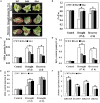Sweetpotato bZIP Transcription Factor IbABF4 Confers Tolerance to Multiple Abiotic Stresses
- PMID: 31156685
- PMCID: PMC6531819
- DOI: 10.3389/fpls.2019.00630
Sweetpotato bZIP Transcription Factor IbABF4 Confers Tolerance to Multiple Abiotic Stresses
Abstract
The abscisic acid (ABA)-responsive element binding factors (ABFs) play important regulatory roles in multiple abiotic stresses responses. However, information on the stress tolerance functions of ABF genes in sweetpotato (Ipomoea batatas [L.] Lam) remains limited. In the present study, we isolated and functionally characterized the sweetpotato IbABF4 gene, which encodes an abiotic stress-inducible basic leucine zipper (bZIP) transcription factor. Sequence analysis showed that the IbABF4 protein contains a typical bZIP domain and five conserved Ser/Thr kinase phosphorylation sites (RXXS/T). The IbABF4 gene was constitutively expressed in leaf, petiole, stem, and root, with the highest expression in storage root body. Expression of IbABF4 was induced by ABA and several environmental stresses including drought, salt, and heat shock. The IbABF4 protein localized to the nucleus, exhibited transcriptional activation activity, and showed binding to the cis-acting ABA-responsive element (ABRE) in vitro. Overexpression of IbABF4 in Arabidopsis thaliana not only increased ABA sensitivity but also enhanced drought and salt stress tolerance. Furthermore, transgenic sweetpotato plants (hereafter referred to as SA plants) overexpressing IbABF4, generated in this study, exhibited increased tolerance to drought, salt, and oxidative stresses on the whole plant level. This phenotype was associated with higher photosynthetic efficiency and lower malondialdehyde and hydrogen peroxide content. Levels of endogenous ABA content and ABA/stress-responsive gene expression were significantly upregulated in transgenic Arabidopsis and sweetpotato plants compared with wild-type plants under drought stress. Our results suggest that the expression of IbABF4 in Arabidopsis and sweetpotato enhances tolerance to multiple abiotic stresses through the ABA signaling pathway.
Keywords: IbABF4; abiotic stress; drought tolerance; salt tolerance; sweetpotato.
Figures











Similar articles
-
A novel sweetpotato bZIP transcription factor gene, IbbZIP1, is involved in salt and drought tolerance in transgenic Arabidopsis.Plant Cell Rep. 2019 Nov;38(11):1373-1382. doi: 10.1007/s00299-019-02441-x. Epub 2019 Jun 10. Plant Cell Rep. 2019. PMID: 31183509 Free PMC article.
-
A novel Cys2/His2 zinc finger protein gene from sweetpotato, IbZFP1, is involved in salt and drought tolerance in transgenic Arabidopsis.Planta. 2016 Mar;243(3):783-97. doi: 10.1007/s00425-015-2443-9. Epub 2015 Dec 21. Planta. 2016. PMID: 26691387
-
BnaABF2, a bZIP transcription factor from rapeseed (Brassica napus L.), enhances drought and salt tolerance in transgenic Arabidopsis.Bot Stud. 2016 Dec;57(1):12. doi: 10.1186/s40529-016-0127-9. Epub 2016 Jun 1. Bot Stud. 2016. PMID: 28597422 Free PMC article.
-
Regulatory role of ABA-responsive element binding factors in plant abiotic stress response.Physiol Plant. 2025 Mar-Apr;177(2):e70233. doi: 10.1111/ppl.70233. Physiol Plant. 2025. PMID: 40251968 Review.
-
Updates on the Role of ABSCISIC ACID INSENSITIVE 5 (ABI5) and ABSCISIC ACID-RESPONSIVE ELEMENT BINDING FACTORs (ABFs) in ABA Signaling in Different Developmental Stages in Plants.Cells. 2021 Aug 5;10(8):1996. doi: 10.3390/cells10081996. Cells. 2021. PMID: 34440762 Free PMC article. Review.
Cited by
-
Advancements in Water-Saving Strategies and Crop Adaptation to Drought: A Comprehensive Review.Physiol Plant. 2025 Jul-Aug;177(4):e70332. doi: 10.1111/ppl.70332. Physiol Plant. 2025. PMID: 40599019 Free PMC article. Review.
-
Blocking IbmiR319a Impacts Plant Architecture and Reduces Drought Tolerance in Sweet Potato.Genes (Basel). 2022 Feb 24;13(3):404. doi: 10.3390/genes13030404. Genes (Basel). 2022. PMID: 35327958 Free PMC article.
-
PfbZIP85 Transcription Factor Mediates ω-3 Fatty Acid-Enriched Oil Biosynthesis by Down-Regulating PfLPAT1B Gene Expression in Plant Tissues.Int J Mol Sci. 2024 Apr 16;25(8):4375. doi: 10.3390/ijms25084375. Int J Mol Sci. 2024. PMID: 38673960 Free PMC article.
-
Unveiling the evolution of VIP1 subgroup bZIP transcription factors in plants and the positive effects of BdiVIP1A on heat stress response in Brachypodium distachyon.Plant Cell Rep. 2025 Jul 25;44(8):179. doi: 10.1007/s00299-025-03572-0. Plant Cell Rep. 2025. PMID: 40711560
-
Comparative Transcriptome and Proteome Analysis of Salt-Tolerant and Salt-Sensitive Sweet Potato and Overexpression of IbNAC7 Confers Salt Tolerance in Arabidopsis.Front Plant Sci. 2020 Aug 27;11:572540. doi: 10.3389/fpls.2020.572540. eCollection 2020. Front Plant Sci. 2020. PMID: 32973858 Free PMC article.
References
-
- Agarwal P. K., Jha B. (2010). Transcription factors in plants and ABA dependent and independent abiotic stress signaling. Biol. Plant 54 201–212. 10.1007/s10535-010-0038-7 - DOI
-
- Bartels D., Sunkar R. (2005). Drought and salt tolerance in plants. Crit. Rev. Plant Sci. 24 23–58. 10.1080/07352680590910410 - DOI
LinkOut - more resources
Full Text Sources

